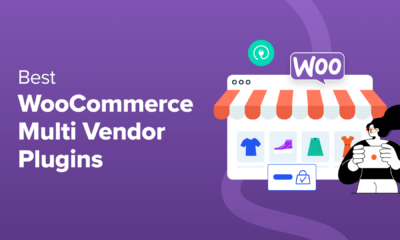SOCIAL
Growth Stock Surges On Ad Fraud Discovery, Analyst Upgrade

Ad data and analytics provider DoubleVerify (DV) is building the right side of a cup base with a buy point of 32.53. The growth stock is today’s selection for IBD 50 Stocks to Watch.
X
DoubleVerify has a strong Composite Rating of 94 and a Relative Strength Rating of 89. Its stellar EPS Rating of 96 is even better.
Company sales grew 35% to $112.3 million in the third quarter while earnings per share of 6 cents grew 20% from the previous year.
On Jan. 10, analysts at Barclays upgraded the stock to overweight from equal weight with a price target of 29. Shares gapped up over 6% on the news, and the move helped the stock start its recovery from the January low.
Growth Stock Surges After Finding Fraud Scheme
DoubleVerify helps advertising companies that target users on video, mobile, and social media platforms. The company also has an analytics side that provides data on consumer engagement.
The digital media analytics platform ensures that ads reach their target customers in a safe way. This means that ads reach actual people with the right context. The software also has tools to adapt ads to different devices.
Its technology also seeks to address ad fraud. On Thursday, the company discovered “BeatSting,” the first large-scale ad-impression fraud scheme that targeted audio ads.
DV Fraud Lab first identified the fraud scheme in 2019, which is largely responsible for advertisers losing $20 million in several scams, according to reports. DoubleVerify was credited for unveiling the fraud. Shares last Thursday surged nearly 4% in strong volume.
Deals With Twitter, LinkedIn, Meta, Facebook
The company has partnered with leading social media and mobile platforms like LinkedIn and TikTok to improve ad impact and experience. DoubleVerify has a long-standing relationship with Facebook parent Meta Platforms (META). The social media platform faced a massive boycott in 2020 when several companies removed their ads due to concerns over their brand safety.
In June of last year, DoubleVerify brought features that will allow marketers to see where their ads appear in a user’s timeline. The feature uses artificial-intelligence tools to understand the context in which ads appear. The feature also enhanced brand safety and attracted Twitter and other social media platforms to try it out. Nonetheless, marketers did not buy in entirely, according to reports, as Twitter’s ad revenue continued to struggle.
The growth stock ranks second in the specialty enterprise software group. The stock went public in April 2021. The New York-based company has locations in the U.S., U.K., Europe, Asia, Australia and South America.
Mutual funds own 39% of shares outstanding. That may not seem like much, but more funds have been picking up the growth stock over the past eight quarters, according to MarketSmith. The stock has an Accumulation/Distribution Rating of B-.
Exchange traded funds hold shares of DoubleVerify as well. The Invesco S&P Small Cap Information Technology ETF (PSCT) and the SPDR FactSet Innovative Technology ETF (XITK) own DV.
Please follow VRamakrishnan on Twitter @IBD_VRamakrishnan for more news on growth stocks.
YOU MAY ALSO LIKE:
Get Stock Lists, Stock Ratings And More With IBD Digital
Find Stocks To Buy And Watch With IBD Leaderboard
Identify Bases And Buy Points With MarketSmith Pattern Recognition
SOCIAL
Snapchat Explores New Messaging Retention Feature: A Game-Changer or Risky Move?

In a recent announcement, Snapchat revealed a groundbreaking update that challenges its traditional design ethos. The platform is experimenting with an option that allows users to defy the 24-hour auto-delete rule, a feature synonymous with Snapchat’s ephemeral messaging model.
The proposed change aims to introduce a “Never delete” option in messaging retention settings, aligning Snapchat more closely with conventional messaging apps. While this move may blur Snapchat’s distinctive selling point, Snap appears convinced of its necessity.
According to Snap, the decision stems from user feedback and a commitment to innovation based on user needs. The company aims to provide greater flexibility and control over conversations, catering to the preferences of its community.
Currently undergoing trials in select markets, the new feature empowers users to adjust retention settings on a conversation-by-conversation basis. Flexibility remains paramount, with participants able to modify settings within chats and receive in-chat notifications to ensure transparency.
Snapchat underscores that the default auto-delete feature will persist, reinforcing its design philosophy centered on ephemerality. However, with the app gaining traction as a primary messaging platform, the option offers users a means to preserve longer chat histories.
The update marks a pivotal moment for Snapchat, renowned for its disappearing message premise, especially popular among younger demographics. Retaining this focus has been pivotal to Snapchat’s identity, but the shift suggests a broader strategy aimed at diversifying its user base.
This strategy may appeal particularly to older demographics, potentially extending Snapchat’s relevance as users age. By emulating features of conventional messaging platforms, Snapchat seeks to enhance its appeal and broaden its reach.
Yet, the introduction of message retention poses questions about Snapchat’s uniqueness. While addressing user demands, the risk of diluting Snapchat’s distinctiveness looms large.
As Snapchat ventures into uncharted territory, the outcome of this experiment remains uncertain. Will message retention propel Snapchat to new heights, or will it compromise the platform’s uniqueness?
Only time will tell.
SOCIAL
Catering to specific audience boosts your business, says accountant turned coach

While it is tempting to try to appeal to a broad audience, the founder of alcohol-free coaching service Just the Tonic, Sandra Parker, believes the best thing you can do for your business is focus on your niche. Here’s how she did just that.
When running a business, reaching out to as many clients as possible can be tempting. But it also risks making your marketing “too generic,” warns Sandra Parker, the founder of Just The Tonic Coaching.
“From the very start of my business, I knew exactly who I could help and who I couldn’t,” Parker told My Biggest Lessons.
Parker struggled with alcohol dependence as a young professional. Today, her business targets high-achieving individuals who face challenges similar to those she had early in her career.
“I understand their frustrations, I understand their fears, and I understand their coping mechanisms and the stories they’re telling themselves,” Parker said. “Because of that, I’m able to market very effectively, to speak in a language that they understand, and am able to reach them.”Â
“I believe that it’s really important that you know exactly who your customer or your client is, and you target them, and you resist the temptation to make your marketing too generic to try and reach everyone,” she explained.
“If you speak specifically to your target clients, you will reach them, and I believe that’s the way that you’re going to be more successful.
Watch the video for more of Sandra Parker’s biggest lessons.
SOCIAL
Instagram Tests Live-Stream Games to Enhance Engagement

Instagram’s testing out some new options to help spice up your live-streams in the app, with some live broadcasters now able to select a game that they can play with viewers in-stream.
As you can see in these example screens, posted by Ahmed Ghanem, some creators now have the option to play either “This or That”, a question and answer prompt that you can share with your viewers, or “Trivia”, to generate more engagement within your IG live-streams.
That could be a simple way to spark more conversation and interaction, which could then lead into further engagement opportunities from your live audience.
Meta’s been exploring more ways to make live-streaming a bigger consideration for IG creators, with a view to live-streams potentially catching on with more users.
That includes the gradual expansion of its “Stars” live-stream donation program, giving more creators in more regions a means to accept donations from live-stream viewers, while back in December, Instagram also added some new options to make it easier to go live using third-party tools via desktop PCs.
Live streaming has been a major shift in China, where shopping live-streams, in particular, have led to massive opportunities for streaming platforms. They haven’t caught on in the same way in Western regions, but as TikTok and YouTube look to push live-stream adoption, there is still a chance that they will become a much bigger element in future.
Which is why IG is also trying to stay in touch, and add more ways for its creators to engage via streams. Live-stream games is another element within this, which could make this a better community-building, and potentially sales-driving option.
We’ve asked Instagram for more information on this test, and we’ll update this post if/when we hear back.
-

 MARKETING7 days ago
MARKETING7 days agoEffective Communication in Business as a Crisis Management Strategy
-

 SEO6 days ago
SEO6 days agobrightonSEO Live Blog
-

 SEO5 days ago
SEO5 days agoGoogle March 2024 Core Update Officially Completed A Week Ago
-
SEARCHENGINES6 days ago
Daily Search Forum Recap: April 25, 2024
-

 WORDPRESS5 days ago
WORDPRESS5 days ago9 Best WooCommerce Multi Vendor Plugins (Compared)
-

 MARKETING4 days ago
MARKETING4 days agoNavigating the Video Marketing Maze: Short-Form vs. Long-Form
-

 SEARCHENGINES5 days ago
SEARCHENGINES5 days agoGoogle March 2024 Core Update Finished April 19, 2024
-

 WORDPRESS7 days ago
WORDPRESS7 days agoYour New Favorite Way to Develop WordPress Locally – WordPress.com News












![The Current State of Google’s Search Generative Experience [What It Means for SEO in 2024] person typing on laptop with](https://articles.entireweb.com/wp-content/uploads/2024/04/The-Current-State-of-Googles-Search-Generative-Experience-What-It.webp-80x80.webp)

You must be logged in to post a comment Login